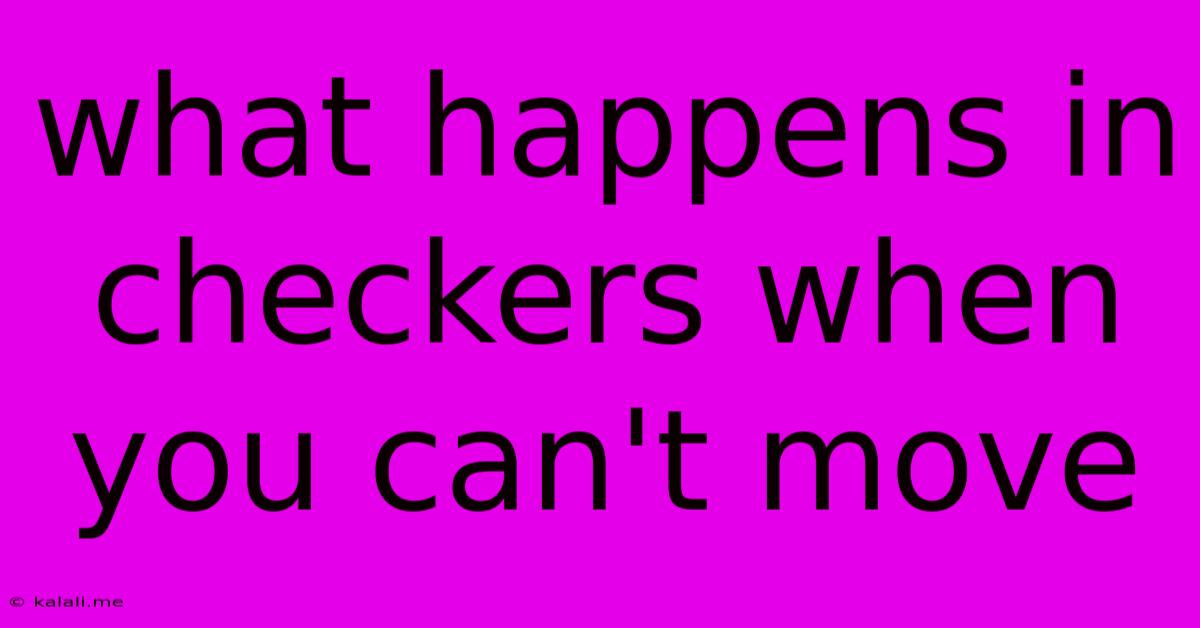What Happens In Checkers When You Can't Move
Kalali
May 30, 2025 · 3 min read

Table of Contents
What Happens in Checkers When You Can't Move? The Rules of a Stalemate
Checkers, a classic game of strategy and skill, is deceptively simple. However, even experienced players can find themselves in situations where they seemingly have no legal moves. This article will explain what happens when you can't move in checkers, exploring the concept of a stalemate and its implications for the game's outcome. Understanding this rule is crucial for mastering the game and avoiding unexpected losses.
Understanding the "No Legal Move" Scenario
In checkers, a player is considered to have no legal moves when they have no pieces that can be moved according to the game's rules. This isn't simply about having no pieces that can capture an opponent's piece; it means absolutely no pieces can be moved, even if it means not making a capture. This situation is distinct from being in check, where your king (or in checkers, your single pieces) are under immediate threat.
What Constitutes a Legal Move?
Before we delve into the outcome of having no moves, let's clarify what a legal move entails:
- Single-piece moves: Pieces move diagonally forward one square at a time, unless a capture is possible.
- Capture moves: If a capture is possible, it must be made. This is a crucial rule. A player cannot choose to ignore a forced capture. Multiple captures can be made in a single turn, following the rules of jumping opponent pieces.
- King moves: Kings, created when a piece reaches the opposite end of the board, can move diagonally forward or backward any number of squares as long as they jump over opponent pieces. Again, captures are mandatory.
The Stalemate Rule: What Happens When You Can't Move?
When a player has absolutely no legal moves available, the game ends in a stalemate. In a stalemate situation:
- The game is a draw. Neither player wins. This is a crucial difference from checkmate, which results in a win for the opponent. A stalemate is a draw for both players.
- The game concludes. No further moves are possible, and the game is officially over.
Distinguishing Stalemate from Checkmate
It's important to differentiate a stalemate from a checkmate. In a checkmate, one player's king (or in checkers, all pieces) is under attack and there is no way to escape the attack. Checkmate leads to a win for the attacking player. A stalemate, however, is a different situation; it is a draw that indicates an inability to make any legal move, regardless of the presence of any threat to the pieces.
Strategies to Avoid Stalemates
While a stalemate might seem like an unfair outcome, it is rare and usually arises from a strategic misstep. Players can avoid stalemates by:
- Careful planning: Always anticipate your opponent's moves and strategize accordingly.
- Managing your pieces: Don't unnecessarily crowd your own pieces, hindering their movement.
- Recognizing forced captures: Always be aware of all capture opportunities, as failing to execute a mandatory capture can lead directly to a stalemate situation.
Understanding the rules surrounding a stalemate is essential for every checkers player. By mastering the nuances of legal moves and anticipating potential scenarios, you can improve your strategic thinking and significantly increase your chances of victory (or at least a draw!).
Latest Posts
Latest Posts
-
A Block On A Ramp Is Balanced Than Started Moving
May 31, 2025
-
Starter Motor Not Engaging With Flywheel
May 31, 2025
-
Ceiling Fan Pull Chain Switch Diagram
May 31, 2025
-
Connections Between Perturbation Theory And Flucturation Dissipation Theorem
May 31, 2025
-
How Rare Is Getting Struck By Lightning In Minecraft
May 31, 2025
Related Post
Thank you for visiting our website which covers about What Happens In Checkers When You Can't Move . We hope the information provided has been useful to you. Feel free to contact us if you have any questions or need further assistance. See you next time and don't miss to bookmark.